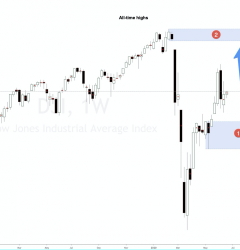09 Apr

Stock markets across Asia and Europe have had a strong sell-off for over two consecutive months; Singapore STI is not an exception to the rule. This strong sell-off has affected most Singapore stocks and investment firms in the STI index and also across the Asian market floors and in all sectors and industries.
Singapore stocks forecast
The STI decreased 656 points or 20.35% since the beginning of 2020, according to trading on a contract for difference (CFD) that tracks this benchmark index from Singapore. The Straits Times Index STI is a major stock market index that tracks the performance of the top 30 companies on the Singapore Exchange. It is a capitalization-weighted index. The STI Index dates back to 1966. Yet, it was recalculated twice in 1998 and 2008 according to the FTSE methodology.
A strong supply level is created around 364, where shorts can be able. There is a clear short bias on the STI index; however, we expect a bigger retracement with a potential bullish bias for a few weeks providing opportunities to buy shares of Singapore STI stocks on the way up. Stocks like DBS and OCBC bank are losing much value with this strong sell-off.
STI stocks and index video analysis
Watch the supply and demand analysis for the Singapore STI index and a few stocks from the Singapore market in the video below.
Singapore STI price action analysis
This is the kind of price action technical analysis you will learn in our trading community. You will learn how to locate new supply and demand imbalances and trade without using any indicators, no news, no fundamental analysis, no earnings announcements, no volume or VSA analysis. Just supply and demand imbalances.
Trading Dax 30 stocks supply and demand imbalances are ideal for beginners and those with a full or half-time job. You won’t need to stay in front of the computer all day long trying to move price action with your mind.
STI supply and demand imbalances
As supply and demand traders, we do not need to pay attention to the news, fundamentals or any earnings reports. Once a big timeframe imbalance has gained control, earnings do just the opposite and react strongly to those imbalances. Why do you see positive earnings, then the underlying stock drops like a rock, or a negative earnings announcement and the stock rallies like a rocket out of control? You are probably missing the fact that there are big imbalances in gaining control.
Unless you are doing very short-term trading and scalping, you should not worry about fundamentals or earnings announcements on the Singapore STI index.
You can use these imbalances to plan your trades in lower timeframes. Trading is just waiting for the right trigger points and scenarios to present themselves, this game has a name, and it’s called the waiting game. We need to patiently wait for the correct scenarios and setups to happen and wait for the price to pull back or dip into the price levels we want to trade, in our case, these price levels are made of supply and demand imbalances.
Join our supply and demand stock trading course if you want to learn how to trade using our supply and demand trading strategy.
There are several ways of buying stocks and futures. When trading stocks, you can buy shares of the underlying stock or use options strategies to go long or short at these specific supply and demand levels, long calls or long puts or spreads. You can even buy a CFD (contracts for difference) if you are in a country where it’s allowed.









